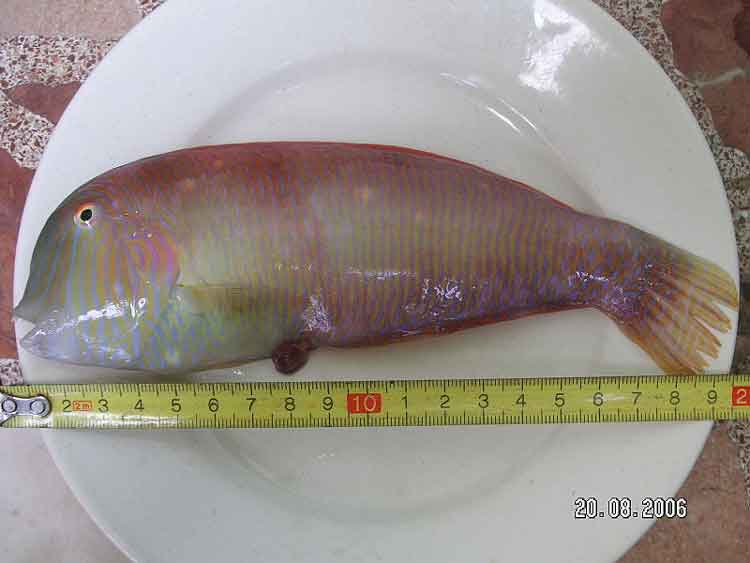
Xyrichtys novacula (*)
SSuperregnum : Eukaryota
Regnum: Animalia
Subregnum: Eumetazoa
Cladus: Bilateria
Cladus: Nephrozoa
Superphylum: Deuterostomia
Phylum: Chordata
Cladus: Craniata
Subphylum: Vertebrata
Infraphylum: Gnathostomata
Megaclassis: Osteichthyes
Superclassis/Classis: Actinopterygii
Classis/Subclassis: Actinopteri
Subclassis/Infraclassis: Neopterygii
Infraclassis: Teleostei
Megacohors: Osteoglossocephalai
Supercohors: Clupeocephala
Cohors: Euteleosteomorpha
Subcohors: Neoteleostei
Infracohors: Eurypterygia
Sectio: Ctenosquamata
Subsectio: Acanthomorphata
Divisio/Superordo: Acanthopterygii
Subdivisio: Percomorphaceae
Series: Eupercaria
Ordo: Labriformes
Familia: Labridae
Genus: Xyrichtys
Species: Xyrichtys novacula
Name
Xyrichtys novacula (Linnaeus, 1758)
Holotype: No types known
Type locality: Mediterranean Sea
Original combination: Coryphaena novacula
Synonyms
Amorphocephalus granulatus Bowdich, 1825
Coryphaena lineata Gmelin, 1789
Coryphaena lineolata Rafinesque, 1810
Coryphaena psittacus Linnaeus (ex Garden), 1766
Hemipteronotus copei Fowler, 1900
Hemipteronotus novacula (Linnaeus, 1758)
Hemipteronotus psittacus (Linnaeus (ex Garden), 1766)
Novacula coryphaena (misspelling) Risso, 1827
Novacula coryphaenoides Schinz, 1822
Novacula coryphena Risso, 1827
Novacula cultrata (Valenciennes in Cuvier & Valenciennes, 1840)
Novacula lineata (Gmelin, 1789)
Novacula lineolata (Rafinesque, 1810)
Novacula novacula (Linnaeus, 1758)
Xyrichthys argentimaculata Steindachner, 1861
Xyrichthys binghami Mowbray, 1925
Xyrichthys cultratus Valenciennes in Cuvier & Valenciennes, 1840
Xyrichthys jessiae Jordan, 1888
Xyrichthys psittacus (Linnaeus (ex Garden), 1766)
Xyrichthys rosipes Jordan & Gilbert, 1884
Xyrichthys uniocellatus Agassiz in Spix & Agassiz, 1931
Xyrichthys vermiculatus Poey, 1860
Xyrichthys vitta Valenciennes in Cuvier & Valenciennes, 1840
References
Linnaeus, C. 1758. Systema Naturae per regna tria naturæ, secundum classes, ordines, genera, species, cum characteribus, differentiis, synonymis, locis, Tomus I. Editio decima, reformata. Holmiæ: impensis direct. Laurentii Salvii. i–ii, 1–824 pp DOI: 10.5962/bhl.title.542: 262. Reference page.
Westneat, M.W. 2003: Labridae (Pp. 1701-1722), Scaridae (Pp. 1723-1739). In: Carpenter 2003. The living marine resources of the Western Central Atlantic. 3.
Xyrichtys novacula in FishBase,
Froese, R. & Pauly, D. (eds.) 2022. FishBase. World Wide Web electronic publication, www.fishbase.org, version 08/2021.
Xyrichtys novacula in the World Register of Marine Species
Vernacular names
English: Pearly Razorfish
Türkçe: Papağan balığı
The pearly razorfish or cleaver wrasse, Xyrichtys novacula, is a species of wrasse. It is of minor importance to local commercial fisheries and is popular as a game fish. It can also be found in the aquarium trade.[2]
Description
Xyrichtys novacula can reach 38 cm (15 in) in total length, though most do not exceed 20 cm (7.9 in). Its body is elongate and very compressed laterally, the head is flattened, with a steep profile and sharp teeth. Its long dorsal fin extends along most of its back. It has 9 dorsal spines, 12 dorsal soft rays, 3 anal spines and 12 anal soft rays. This wrasse has a yellow-orange or reddish-pink color that is darker on the back and lighter on the belly, sometimes marked with green and gray stripes. Head shows vertical narrow light blue lines and there are scales with brisk reflexes on the abdomen. Upon capture, this fish has been known to turn its mouth and sharp protruding teeth past 90 degrees to either side in relationship to its own body as an attempt to be released from capture.[2]
Distribution and habitat
The pearly razorfish is widespread throughout the western and eastern subtropical and tropical Atlantic Ocean, as well as the Mediterranean Sea. It inhabits clear, shallow littoral areas with sandy or muddy bottoms, at depths of 1 to 20 m. In winter it migrates to greater depths, up to 90–150 m.
Behavior and diet
Xyrichtys novacula buries itself rapidly in the bottom when disturbed. It feeds on small invertebrates such as crustaceans, mollusks and echinoderms.[2]
X. novaculae caught in Santorini, Greece
Synonyms
A large number of specific names have been determined to refer to this species as junior synonyms:[2]
Coryphaena novacula Linnaeus, 1758
Hemipteronotus novacula (Linnaeus, 1758)
Novacula novacula (Linnaeus, 1758)
Coryphaena psittacus Linnaeus, 1766
Hemipteronotus psittacus (Linnaeus, 1766)
Xyrichthys psittacus (Linnaeus, 1766)
Coryphaena lineata J. F. Gmelin, 1789
Novacula lineata (J. F. Gmelin, 1789)
Coryphaena lineolata Rafinesque, 1810
Novacula lineolata (Rafinesque, 1810)
Amorphocephalus granulatus S. Bowdich, 1825
Novacula coryphena A. Risso, 1827
Novacula coryphaena A. Risso, 1827
Xyrichthys uniocellatus Agassiz, 1831
Xyrichthys cultratus Valenciennes, 1840
Novacula cultrata (Valenciennes, 1840)
Xyrichthys vitta Valenciennes, 1840
Xyrichthys vermiculatus Poey, 1860
Xyrichthys argentimaculata Steindachner, 1861
Xyrichthys rosipes D. S. Jordan & C. H. Gilbert, 1884
Xyrichthys jessiae D. S. Jordan, 1888
Hemipteronotus copei Fowler, 1900
Xyrichthys binghami Mowbray, 1925
Predators
The Pearly razorfish has been shown to be successful bait for the Greater Amberjack species (aka reef donkey).
References
Pollard, D.; Rocha, L.; Ferreira, C.E.; Francini-Filho, R.; Moura, R.R. (2010). "Xyrichtys novacula". IUCN Red List of Threatened Species. 2010: e.T187696A8603436. doi:10.2305/IUCN.UK.2010-4.RLTS.T187696A8603436.en. Retrieved 19 November 2021.
Froese, Rainer; Pauly, Daniel (eds.) (2013). "Xyrichtys novacula" in FishBase. October 2013 version.
External links
Xyrichtys novacula. Marine Species Identification Portal. Downloaded on 25 May 2013.
WoRMS
Bibliography
Eschmeyer, William N., ed. 1998. Catalog of Fishes. Special Publication of the Center for Biodiversity Research and Information, n. 1, vol. 1-3. California Academy of Sciences. San Francisco, California, USA. 2905. ISBN 0-940228-47-5.
Fenner, Robert M.: The Conscientious Marine Aquarist. Neptune City, New Jersey, USA: T.F.H. Publications, 2001.
Helfman, G., B. Collette y D. Facey: The diversity of fishes. Blackwell Science, Malden, Massachusetts, USA, 1997.
Hoese, D.F. 1986: . A M.M. Smith y P.C. Heemstra (eds.) Smiths' sea fishes. Springer-Verlag, Berlín, Germany.
Maugé, L.A. 1986. A J. Daget, J.-P. Gosse y D.F.E. Thys van den Audenaerde (eds.) Check-list of the freshwater fishes of Africa (CLOFFA). Bruxelles; Vol. 2.
Moyle, P. y J. Cech.: Fishes: An Introduction to Ichthyology, 4th. ed, Upper Saddle River, New Jersey, USA: Prentice-Hall. 2000.
Nelson, J.: Fishes of the World, 3rd. Ed. New York City, USA: John Wiley and Sons. 1994.
Wheeler, A.: The World Encyclopedia of Fishes, 2nd. Ed., London: Macdonald. 1985.
Retrieved from "http://en.wikipedia.org/"
All text is available under the terms of the GNU Free Documentation License

